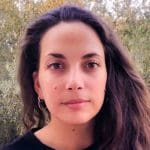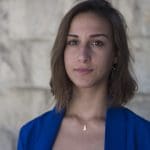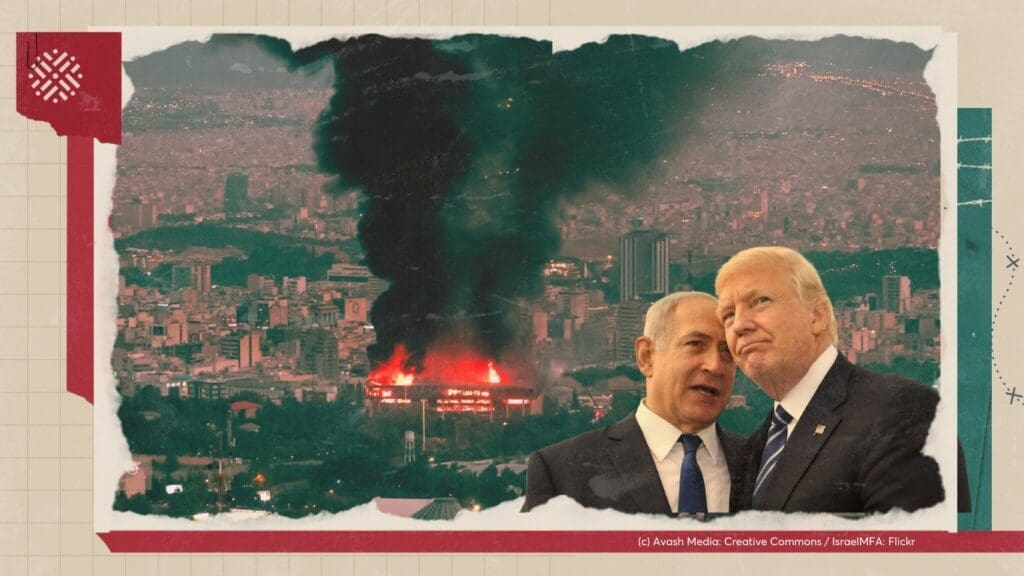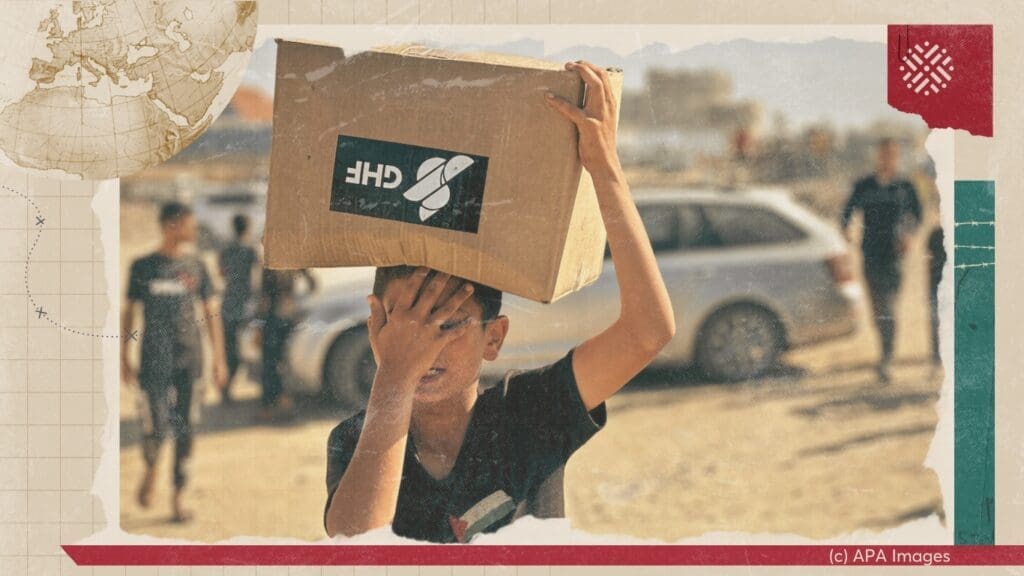- Topics
-
Topics
See our analysis on civil society and how it shapes culture, politics, and policies
Read our insights on the shifting political landscape and what it means for Palestine
Learn more about the policies and practices shaping the Palestinian economy
Strengthen your understanding of the unique conditions for Palestinian refugees across the Middle East
-
- Analysis
-
Analysis
In-depth analysis on existing or potential policies that impact possibilities for Palestinian liberation.
Insights and perspectives on social, political, and economic questions related to Palestine and Palestinians globally.
Concise analysis into a specific policy, its background and implications.
Commentary that brings together insights from multiple analysts.
Compilations of past Al-Shabaka works surrounding a specific theme.
Longer-form, ad hoc projects that seek to confront research questions outside the scope of our regular analysis.
A policy-driven research initiative by Al-Shabaka: The Palestinian Policy Network.
Our monthly webinar series that brings together Palestinian experts.
Featured
On Thursday, June 19, 2025, Israeli Prime Minister Benjamin Netanyahu stood in front of the aftermath of an Iranian strike near Bir al-Saba’ and told journalists: “It really reminds me of the British people during the Blitz. We are going through a Blitz.” The Blitz refers to the sustained bombing campaign carried out by Nazi Germany against the UK, particularly London, between September 1940 and May 1941. With this dramatic comparison, Netanyahu sought to elicit Western sympathy and secure unconditional support for his government’s latest act of military escalation and violation of international law: the unprovoked bombing of Iran. This rhetorical move is far from new; it has become an enduring trope in Israeli political discourse—one that casts Israel as the perennial victim and frames its opponents as modern-day Nazis. Netanyahu has long harbored ambitions of striking Iran with direct US support, but timing has always been central. This moment, then, should not be viewed merely as opportunistic aggression, but as part of a broader, calculated strategy. His actions are shaped by a convergence of unprecedented impunity, shifting regional dynamics, and deepening domestic political fragility. This commentary examines the latest escalation in that context and discusses the broader political forces driving it. Yara Hawari· Jun 26, 2025Launched on May 26, 2025, and secured by US private contractors, the new Israeli-backed aid distribution system in Gaza has resulted in over 100 Palestinian deaths, as civilians navigated dangerous conditions at hubs positioned near military outposts along the Rafah border. These fatalities raise grave concerns about the safety of the aid model and the role of US contractors operating under Israeli oversight. This policy memo argues that the privatization of aid and security in Gaza violates humanitarian norms by turning aid into a tool of control, ethnic cleansing, and colonization. It threatens Palestinian life by conditioning life-saving aid, facilitating forced displacement, and shielding the Israeli regime from legal and moral responsibility. It additionally erodes local and international institutions, especially UNRWA, which has been working in Gaza for decades.
Yara Hawari· Jun 26, 2025Launched on May 26, 2025, and secured by US private contractors, the new Israeli-backed aid distribution system in Gaza has resulted in over 100 Palestinian deaths, as civilians navigated dangerous conditions at hubs positioned near military outposts along the Rafah border. These fatalities raise grave concerns about the safety of the aid model and the role of US contractors operating under Israeli oversight. This policy memo argues that the privatization of aid and security in Gaza violates humanitarian norms by turning aid into a tool of control, ethnic cleansing, and colonization. It threatens Palestinian life by conditioning life-saving aid, facilitating forced displacement, and shielding the Israeli regime from legal and moral responsibility. It additionally erodes local and international institutions, especially UNRWA, which has been working in Gaza for decades. Safa Joudeh· Jun 10, 2025In this policy lab, Mariam Barghouti and Sharif Abdel Kouddous join host Tariq Kenney-Shawa to discuss Israel’s targeted assassination campaign against Palestinian journalists, the complicity of Western media in normalizing these crimes, and how this silence allows Israel to get away with genocide.
Safa Joudeh· Jun 10, 2025In this policy lab, Mariam Barghouti and Sharif Abdel Kouddous join host Tariq Kenney-Shawa to discuss Israel’s targeted assassination campaign against Palestinian journalists, the complicity of Western media in normalizing these crimes, and how this silence allows Israel to get away with genocide. Mariam Barghouti· May 28, 2025
Mariam Barghouti· May 28, 2025
-
- Resources
- Media & Outreach
- The Network




Unifying Palestinians Through Education: Lessons from Experience
The system of higher education serving the Palestinian people has contributed to and been impacted by national fragmentation over the decades. At present, given the current political divisions and physical barriers within the Occupied Palestinian Territory (OPT), between the OPT and the Palestinian citizens of Israel, and with Palestinian refugees, it is difficult to remember a time when higher education brought Palestinians together. Less than 20 years ago, in 2000, a significant number of the students at Birzeit University were from the Gaza Strip – 350 – a figure that plummeted to 35 by 2005. Today, it is difficult for a student from Ramallah to consider studying in Hebron. Each university primarily serves its surrounding area.
Throughout the decades, there have been efforts to liberate the education system from the yoke of Israel’s occupation as well as to use education as a means of reunifying the Palestinian body politic, but they have yet to succeed. Perhaps the most recent attempt was launched in 2015. Its aim was to establish a Palestinian university outside Palestine in order to escape the geographic limitations placed by foreign powers, both military occupiers and governments. It also aimed to create future generations of leaders by drawing on Palestinian potential within the homeland and in the diaspora. Although the university did not come to fruition, the feasibility study for this project produced a valuable store of documentation and lessons learned both from the initiative itself as well as from other past projects that similarly aimed to empower and bring together Palestinians through higher education.
In this commentary, Al-Shabaka policy analyst Sam Bahour, who was behind the 2015 initiative to establish a Palestinian university in Cyprus, begins by discussing the process followed in that initiative. He then reviews the attempt to establish a university in the West Bank as well as in the Gaza Strip in the early 1970s and discusses the problematic role that Israeli officials played in both. Finally, he reviews the initiative to develop a Palestine Open University in the mid- to late-1970s that was launched by the Palestine Liberation Organization (PLO), in collaboration with the UN Educational, Scientific, and Cultural Organization (UNESCO) as well as the Arab Fund for Economic and Social Development (AFESD). He concludes with lessons learned and recommendations for those who might take up similar projects in future.1
A Palestinian University in Cyprus
In 2015, I began working with a team to try to leverage the vast experience of Palestinian higher education institutions operating in the OPT to establish a university outside of Palestine. This university was to bring together Palestinian students from the OPT to the same classrooms with Palestinian students from inside Israel and from across the region, including refugees in Lebanon, Syria, Jordan, and elsewhere, alongside Palestinians in the diaspora. We also envisioned some Arab and international students, teachers, and staff who were in solidarity with the Palestinian struggle.
The university would be the first Palestinian-affiliated university abroad – an independent, secular, and coeducational institution that would combine the best elements of a multitude of education systems and have quality standards and an international philosophy, all with an indigenous underpinning uniting Palestinians and others in education. One of the core reasons we had for conceptualizing a Palestinian university outside of Palestine was this: Given the geographic fragmentation coupled with the donor-influenced education agenda that accompanied the post-Oslo period, it was clear that existing Palestinian educational institutions would not be able to address the complex totality of the Palestinian people, regardless of their physical location.
The potential location was the Republic of Cyprus due to its unique geographic position cradling Europe and the Middle East and its historic business, political, and cultural ties to the Arab world. The fact that it was part of the European Union, thus requiring compliance to EU education standards, also made Cyprus an ideally suited venue, given that Palestine itself is small and seeks regional inclusion. Furthermore, the country had always been supportive of the Palestinian struggle for freedom and independence, not to mention that Cyprus is experiencing its own brand of military occupation by Turkey, which would have provided an ideal comparative case study for Palestinian students.
It is difficult to remember a time when higher education brought Palestinians together Share on XWe brought on board a leading Palestinian university as an academic partner, but there was a caveat. It was so stretched in terms of human capacity and financial resources, it could do little more than to lend its insights and brand to the project to get the ball rolling. Three leading Palestinian corporate social responsibility funds heeded our call for seed money to get a pre-feasibility study started. Although the funds granted were small, we felt it was strategic that Palestinians in Palestine registered their material support to reach out to Palestinians abroad. Our team of consultants, which included a European-based Palestinian expert in higher education, visited Cyprus and met with many potential stakeholders, Cypriot university administrators, Cypriot and other professors, legal experts, and investors.
A LinkedIn group called Academic Network for Palestine was established to begin to identify future academics who might have a role in the project. We reached out to scholars from Palestine to Harvard University and others across the Arab world. Nearly 250 interested persons subscribed, most of whom were academics and scholars. We also sought out an academic model that would provide for the utmost flexibility and personalized learning, which led us to Quest University Canada, Canada’s first independent, not-for-profit, secular university with an innovative pedagogy. Unlike traditional universities in which students take several classes simultaneously in a semester, Quest’s students focus on single “block” courses that run three hours a day, every day, for three and a half weeks. We saw this as an opportunity for focus, exploration, and flexibility as a value-added to students coming from a region with little, if any, of these elements.
With positive indicators from our pre-feasibility study in hand, we came to our educational partner and seed funders to conduct a full feasibility study. However, the Palestinian university, our academic partner, was still in no position to contribute, financially or otherwise, to a full feasibility study. Without an academic partner on board, our seed funders felt that investing any further, when demands in Palestine were on the rise, was too much to take on. The effort was stopped in its tracks.
Yet all was not for naught: We learned that there was interest in such an initiative, made good contacts, and have a roster to draw on for the future. One clear lesson for future efforts would be to identify an additional academic partner outside of Palestine that would have had fewer constraints than Palestinian institutions, while also diversifying sources of seed money. What was most valuable, however, was that in the course of working on the project we uncovered other Palestinian attempts to use education as a unifying platform. These efforts, as well as our own, provide a resource for others to draw from in the future – as well as indications of pitfalls to avoid.
Efforts to Set Up Universities in the OPT – and Israel’s Role
Perhaps few will remember the attempt, in the early 1970s, to set up an Arab university in the West Bank as well as in the Gaza Strip. The effort was well-chronicled, including by Mahmoud Falaha in the October 1973 issue of the Palestine Liberation Organization (PLO) Research Center publication, Palestinian Affairs Magazine.
Falaha noted that the purpose of the two Arab universities was to give Palestinian students the ability to earn a higher education degree without needing to travel abroad. A Preparatory Committee had been formed in August 1972 in the West Bank with Hebron’s mayor, Sheikh Mohammad Ali Al-Jabari, among the members. The Preparatory Committee then attained permission from the Israeli military governor and made a formal request to Yigal Allon, Israel’s Minister of Education and Culture.2
Separately, that same year, the Israeli authorities approved the establishment of a higher education institution with four branches.3 Indeed, Allon revealed the establishment of an Arab Higher Education Institution during a meeting with Al-Jabari and other Preparatory Committee members.4 At the same time, Allon also recognized the Committee and its activities and formally agreed to Al-Jabari’s request that Israel allow professors from Arab and other countries to participate and that the committee could fundraise from abroad. Allon suggested that the committee make use of Israeli higher education institutions and in March of 1973 the Israeli military authorities approved the university’s establishment.
A charitable association was founded for the purpose of establishing the university and its bylaws and goals were published by Haaretz.5 The founders expected to start operations as soon as October 1973 with an initial phase that would serve approximately 1,000 students and have a presence in several West Bank cities: a law faculty in Ramallah, a faculty of arts and social sciences in Nablus, a faculty of natural sciences and agriculture in Tulkarem, and a faculty of Islamic studies in Hebron. In an echo of the present day, the bylaws stipulated that that the university would not delve into political issues and would remain solely focused on academics. Further, the university’s programs would be approved only after ensuring that they would not “incite” against “Israel and the Jewish people.”
Another seemingly recent phenomenon – Gaza’s separate development from that of the West Bank –turns out not to be new. About the same time as these efforts were taking place in the West Bank, a delegation from Gaza submitted a memo to Moshe Dayan regarding the establishment of an Arab university in Gaza.6 The delegation had recently returned from Cairo, where it had learned that Egypt would financially support the project if residents of Gaza requested it. The university would be independent but would need academic assistance, which it would seek from the Hebrew University. It would start by opening faculties in engineering, agriculture, and medicine and would recruit Palestinian professors from Arab counties and globally, once the Israeli authorities granted permission.
After a long period of silence, reports of a conflict between Allon and Dayan about the Gaza university surfaced.7 This reflected the Labor Party’s deeper concerns regarding the politics of “the territories.” Dayan favored the Egypt link because he desired all the residents of the territories to be connected as citizens of surrounding Arab states, whereas Allon wanted the Gaza university to be linked in the future with the university being established in the West Bank. The Allon-Dayan debate was not about an interest in education, but was rather rooted in two competing Israeli visions of the solution to the OPT since 1967.
Palestinians are finding it more difficult by the day to find a geographic space where they can make plans for the future Share on XThe ultimate motivation for Israel in contemplating these universities, Falaha argues, was similar to its support of municipal elections: to relieve itself from its responsibilities toward the people it occupied, all the while putting a civil façade on its military occupation. Moreover, it became clearer that, through the Preparatory Committee, a Zionist influence was at work in promoting this project and directing it from behind. Indeed, Allon told London’s New Middle East Magazine in May 1973 that it was “natural” that an Arab university would bring together representatives of all the important Israeli settlements in the West Bank, which could have political ramifications in the future.
The Institute of Palestinian Studies (IPS) documented the public outcry against the project.8 Palestinian opposition was based on several reasons: 1) the fact that Jerusalem was not considered as the headquarters for the university; 2) the fear that Israeli hegemony would dominate the university given its establishment under occupation; and 3) disagreement over whether the university should be independent or linked to the University of Jordan. The discussion also spilled over into Arab countries and the Arab League, where voices spoke out against the West Bank university and proposed ways Palestinians could access higher education at universities in Arab states, including establishing an Arab university for Palestinian students outside of Palestine.
At the Arab League’s 59th Session, held in Cairo in May 1973, the League’s Board for Education passed Resolution 3028 (7/4/1973) for the league to commission, in cooperation with the PLO, a study for establishing an Arab university for Palestinian students in an Arab country to which the Arab states would contribute funding. The resolution was never implemented although, as Falaha noted, it would have been more appropriate for Arab states to open the doors of their universities to Palestinian students and provide them with any needed funding support, thus reducing the overall costs, as well as providing an immediate alternative to the Israeli plan.
A Palestine Open University in the Arab States
There was another effort during the 1970s to establish an Arab university for the Palestinians as we learned from our consultations with higher education stakeholders in Palestine and our review of documents preserved by the PLO’s Research Center and IPS. This initiative began in 1975 with a similar idea, albeit a different intent: a Palestine Open University. The PLO had noted the problems Palestinians faced in access to higher education as well as the mismatch between education and the needs of Palestinian society. The Palestine National Fund turned to UNESCO to assess the feasibility of an “open learning system” for Palestinians.9
In collaboration with the Arab Fund for Economic and Social Development and the PLO, UNESCO pulled together a team of experts that produced a pre-feasibility study in 1976 and then recommended a full feasibility study. Dr. Ibrahim Abu-Lughod led the Feasibility Study Team, which included some of the top Palestinian educators of the time.
The feasibility study stated the justification for such a project, the first being the “numerical.” This was based on the estimate that 2,285,000 Palestinians were located in the “area outside Mandatory Palestine” and 1,175,000 located “within Mandatory Palestine” (Israel, the West Bank, and the Gaza Strip). Overall, a total of 40,000 Palestinians graduated from secondary schools annually, with 30,000 having “no access whatsoever to higher education.”
The study went on to other dimensions, “quality” being high on the list. It noted that “nowhere today are the Palestinians educated in accordance with the priorities of Palestinian society or the Palestinian people.” Nor were Palestinians educated in accordance with a curriculum of their own design; rather, they were fragmented between Israel, the OPT, the Arab states, and non-Arab institutions. As noted above, this was very much the reason that we, in 2015, had launched our initiative for a Palestinian university outside of Palestine.
The 1976 study went on to adopt an “open learning system,” making use of modern technology to reach the widest sector of the Palestinian people irrespective of locale and accommodate large numbers. It would also combine distance learning with face-to-face interaction as well as practical work experience. Looking back at this initiative, one is struck by the rationale for this “open” approach in that the university was conceived pre-internet and by a people existing under serious threat of being further dispossessed.
The study then addressed the same core principle we had constructed as the backbone of our project: an approach to “overcoming the problems of national fragmentation of the Palestinians.” It argued that including considerable face-to-face interaction would not only strengthen distance education, but would “more importantly [be] a means of over-riding the problems of national fragmentation.” It would help to overcome the “institutionalized obstacles which prevent Palestinians from interacting.” The Open University planned to organize its own networks in Palestinian areas of concentration in the form of regional centers that would contain facilities such as a library, common viewing rooms, and audio-visual equipment.
The next recommendation was one that also matched the goals of our more recent project: The curriculum had to be Palestinian for the entire project to make sense. The university would not just educate Palestinians, but future Palestinian leaders, each in their individual, sectorial area of expertise, who knew who they were and where they came from.
It described how the type of education and structure of training would differ from those in other areas by being tied to the present and future needs of Palestinian society. For example, whereas “conventional university education has contributed to the growth of certain professions… it has not contributed to the training of cadres of staff needed in hospital and clinical administrations, to the development of food technology and the like.” It would also invest in Palestinian identity and cultural heritage, including those aspects related to Arab culture as a whole – “precisely the ones that are missing from the curriculum in which Palestinians are educated today.”
Israeli leaders know well that the more Palestinians are denied the right to mingle in a shared space, the less likely they are to pose a threat to Israel’s hegemony Share on XWhat would be taught was not only about national identity, but would be geared toward applied learning to save a society under attack. The study went to great strides to define the types of courses and programs needed to “properly educate Palestinian youth to comprehend the nature of their predicament.” The agricultural engineer would be encouraged to reside in rural areas “rather than become an urban bureaucrat shuffling papers on agriculture” while the social scientist would be trained to serve small-scale institutions, municipalities, and district offices. The “dispersal of the Palestinian people, the small size of all the towns in Palestine… and the large number of refugee camps all call for planners, managers and social scientists… equipped with problem-solving skills of a unique nature.”
Then came the key question for anything Palestinians want to strategically do: Where? The location question challenged the authors in the study just as it did us in 2015. The 1975 study envisaged a headquarters in Beirut or Amman and regional centers in Lebanon, Damascus, Amman, and Kuwait. By contrast, in 2015 the reality of the Arab world as it related to Palestinians being free to operate had changed so drastically that we sought to place our project as close to the region as possible but out from under the heavy hand of Arab governments.
UNESCO was appointed as the “executing agency” in 1975 and contributed $72,000 to the study. AFESD contributed $382,000. These two organizations, along with the PLO, were parties to the tripartite agreement in December 1977 that undertook the study. The Palestine Open University feasibility study cost $454,000 in 1977 (some $1.9 million in 2018 dollars). In contrast, my team and I were unable to secure a fraction of that to conduct our own feasibility study in 2018, reaffirming that such national efforts require public sector investment rather than solely private sector interventions.
Lessons for Educators of the Future
Seventy years of dispossession and 50 years of military occupation take a toll on a people, no matter how just their cause or how steadfast they remain. Palestinians are collectively impacted by prolonged conflict as Israel continues to rip apart their social fabric. But they have neither collapsed nor surrendered. Rather, they learn. Although our project hit a bottleneck, there are a few lessons from our 2018 university as well as the efforts of the 1970s that are worth documenting.
Perhaps most importantly, no body whether public or private can assume the responsibility for developing a sector alone. No matter how noble the effort a national project, such as uniting Palestinians through education, it must be undertaken with national leadership.
Indeed, the private sector in Palestine can only be expected to undertake so much effort on national, let alone, transnational, issues. Aside from a handful of firms, many of which thrive on rentier arrangements, the majority of Palestine’s private sector is stretched beyond its limit. The private sector’s responsibilities must be to provide sustainable employment opportunities and fairly compete to keep the cost of living under military occupation as low as possible. That is the private sector’s ultimate value-added to this phase of the Palestinian struggle. To expect it to assume tasks better suited to the political agency – the PLO – is asking too much.
As for the higher education institutions operating in Palestine under military occupation, they are in no position, financially or otherwise, to assume the responsibility for educating Palestinians abroad. Expecting the Palestinian Ministry of Education and Higher Education to spearhead such a task is only wishful thinking. Although the ministry welcomed our concept, its mandate is limited to the affairs of Palestinians living in the OPT.
Thus the Open University effort of the 1970s had the correct stakeholders at the table. The PLO had at one point in its early history some of the foresight and integrity to mobilize the best of Palestinian minds to address such ambitious projects. Today, it is weakened and lacks serious representation and legitimacy. A generation of Palestinians has grown up with no notion of what such a political agency means. This catastrophic result is self-inflicted damage rather than caused by Israeli actions.
The issue of where to locate national projects remains a Palestinian dilemma. Palestinians are finding it more difficult by the day to find a geographic space where they can make plans for the future. Palestine remains under the yoke of Israeli military occupation while the discrimination against Palestinian citizens of Israel rises to the level of apartheid. In the Arab region, Palestinians are challenged by political instability and lack of freedoms. Globally, countries that today may seem like a plausible location can easily become inopportune as a state’s interests shift over time. Cyprus had always been friendly to Palestinians as had Greece. Now the natural gas reserves discovered in Cypriot waters have upended those positions.
Geographic fragmentation and its ensuing economic, cultural, and societal fallout are a disaster for a people. The more we studied the various groups of potential students for the university, the more we learned about how each geographic fragment has developed in very distinct ways. Nationalism aside, the Palestinian student coming from Jericho does not necessarily have much in common today with those coming from Nazareth or Gaza or Dubai or Ein al-Hilweh refugee camp or Boston. Israeli leaders know well that the more Palestinians are denied the right to mingle in a shared space, the less likely they are to ever pose a serious threat to the hegemony of Israel between the Mediterranean Sea and the Jordan River.
Yet Palestinians, an indigenous, albeit struggling, people, are not going to disappear, as our history has shown. Education could play a vital role in unifying our people. Until such time as a national representative body can once more take on its responsibilities, a network of educators could draw on the Open University model and other experiences described above. Indeed, these experiences provide the basic elements of a common Palestinian education that may yet be disseminated globally and tapped locally.
Sam Bahour
Latest Analysis
Timed for Impunity: Israel’s War on Iran
Outsourcing Occupation: US Private Contractors in Gaza
Israel’s War on Palestinian Journalists
We’re building a network for liberation.
As the only global Palestinian think tank, we’re working hard to respond to rapid developments affecting Palestinians, while remaining committed to shedding light on issues that may otherwise be overlooked.